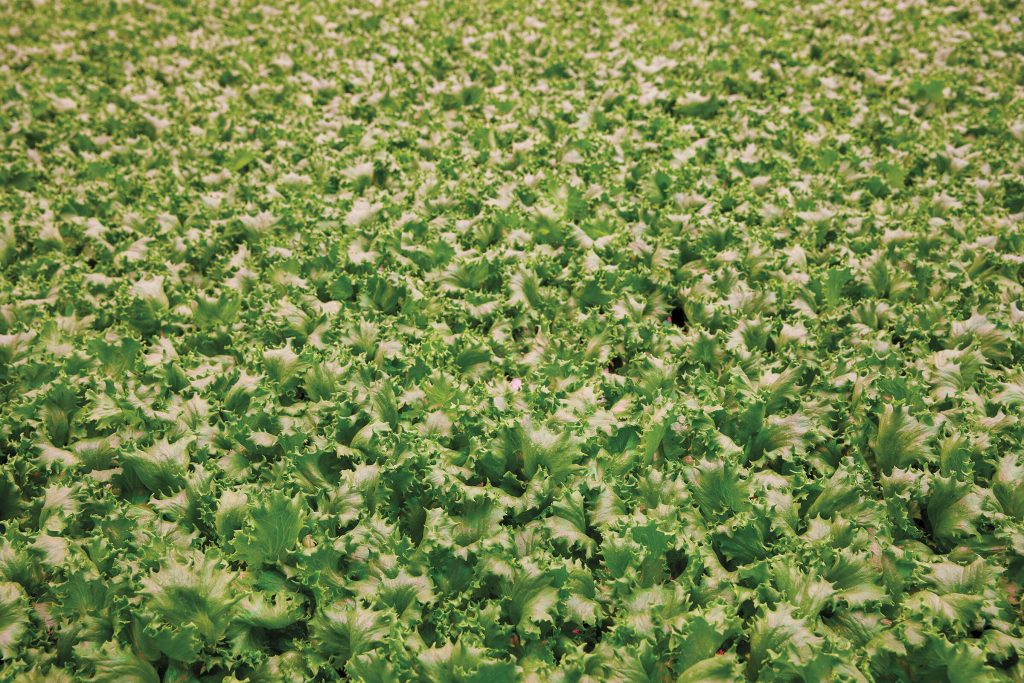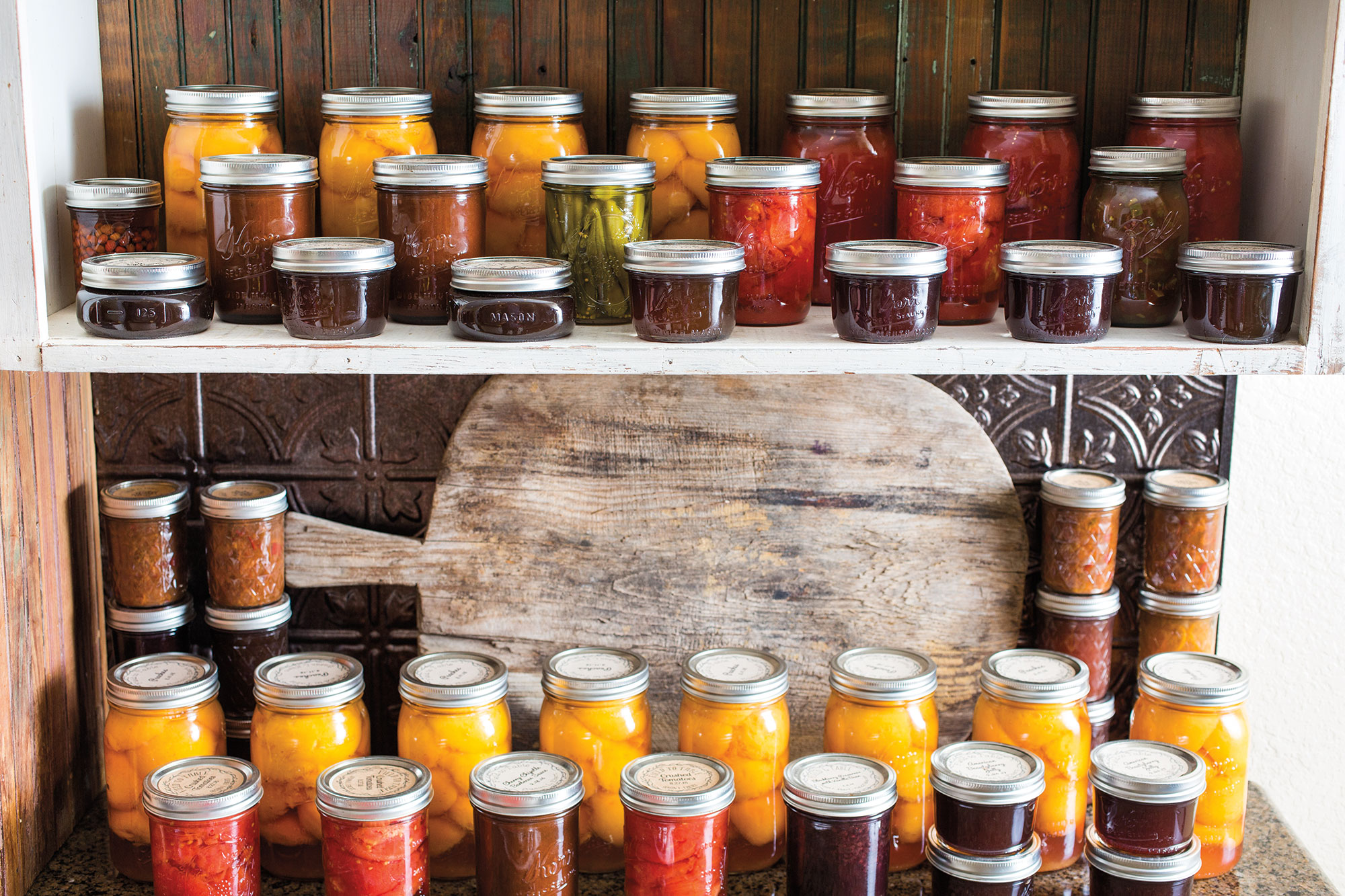
As a child, one of the first things I did upon arriving at my Mamaw Grace and Papaw Dorsey’s rambling fieldstone farmhouse in Kentucky was to open the cellar door off the main dining room. Slowly, I crept down the wooden stairs, allowing my eyes to adjust to the dim light. A single shaft of sunlight from the cellar window illuminated the far stone wall—or what would have been the wall had it not been obscured from floor to rafters by glistening glass-encased riches in every color of the rainbow.
Wine-colored blackberry jams, crimson-hued strawberry preserves, ruby-red orbs of tomatoes in half-gallon jars, and glistening garnet jars of beets provided lush background tones to sunrise-gold peaches, butter-bright corn, alabaster-pale pears, snowy sauerkraut, grassy-toned green beans, and army-green glints of pickles and okra—all glimmering like mined jewels in the cellar’s cave-like gloom. “Bring up whatever you like,” Mamaw Grace would call down. I’d often make several trips.
Then, canning seemed like such alchemy to me. But under my mamaw’s gentle tutelage, I learned to become proficient in helping to turn that Kentucky bluegrass farm’s well-tended vegetable gardens and wild fruit into the yearlong delights I loved.
My own Montgomery County property—shielded from the sun by a canopy of tall pine, oak, elm, and hickory trees—doesn’t lend itself to prolific gardening. But my desire to preserve nature’s bounty by canning it for future enjoyment has not ebbed. What to do? I take to Texas’ highways and byways. Thankfully, with the width and breadth of Texas and its long seasons, fruits and vegetables that are ready to can are available nearly year-round.
“Today’s folks have more varied reasons for home canning than simply putting up produce they’ve grown themselves,” says Jenna Anding, a Texas A&M University professor and program leader for Texas A&M AgriLife Extension Service. “Saving money may not be the main concern. People also can to retain control over the quality of their food, and to preserve seasonal bounty at the height of freshness.”
Count me as one of those: My sturdy wire baskets and gardening gloves pretty much reside in the back of my Jeep year-round, so I can wheel in at a roadside stand, farm, or farmers market on a whim. And I prepare to strike at the height of freshness by studying methods and recipes well in advance, as well as stocking dozens of Ball canning jars and lids on my pantry shelf, my equipment at the ready. I wouldn’t want to come home from the Poteet Strawberry Festival, for example, with basket-loads of strawberries only to let them spoil while I race around to find recipes and buy jars, lids, seals, pectin, sweetener, and other ingredients.
From farmers markets and festivals to pick-your-own farms and farm stands, Texas abounds with bountiful fresh fruits and vegetables all year long. Toss your baskets in the back, and let’s get started!
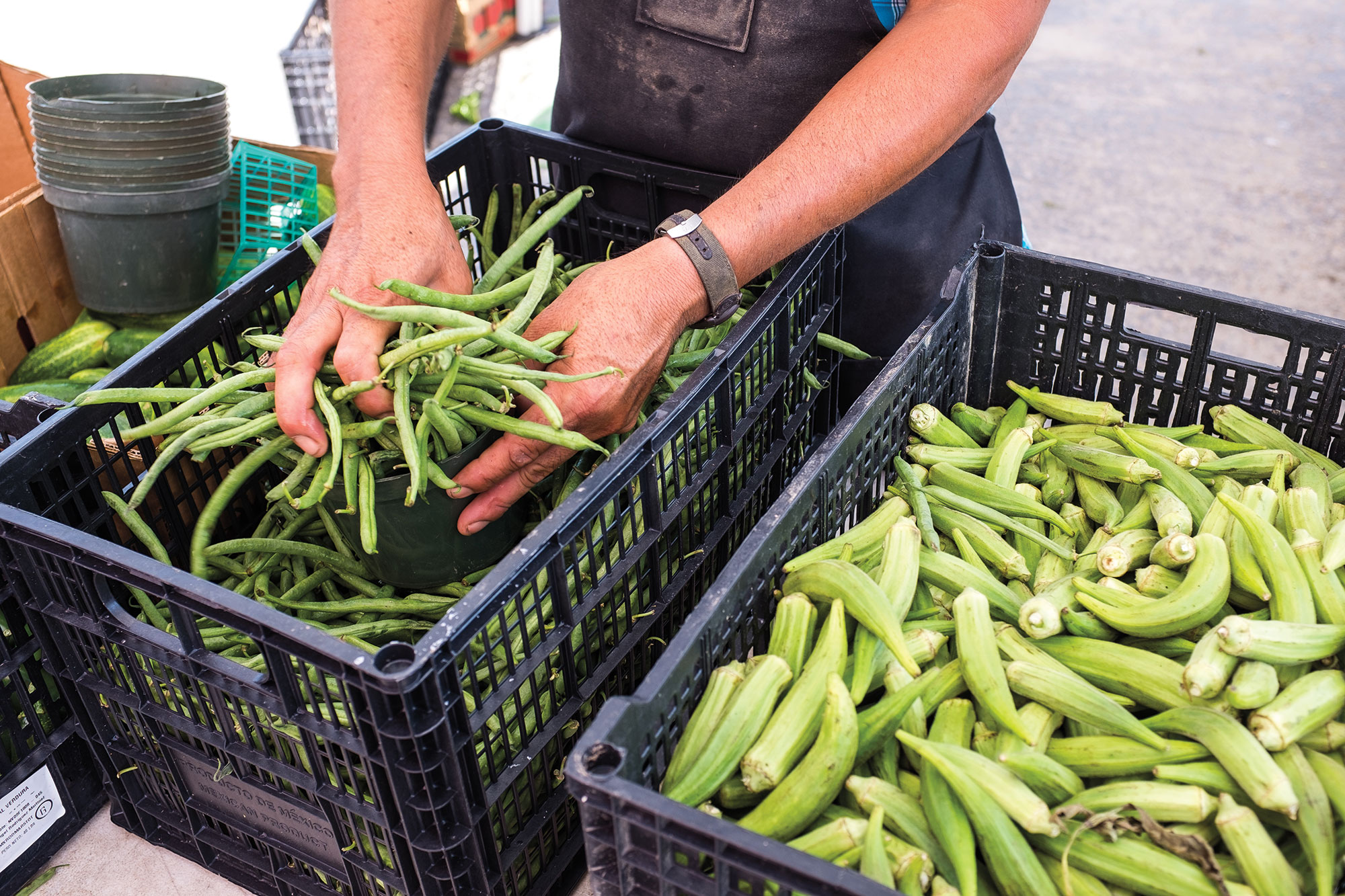
Houston’s Urban Harvest Farmers Market. Photo: Tom McCarthy Jr.
Farmers Markets
Farmers markets of all sizes, each with their own local flavor, can be found across the state. I like to shop markets near closing time, as farmers look to empty their stands rather than cart their wares home: a simple tip that’s won me many half-price deals. Also, when quantities appear limited, I’ll visit with vendors and inquire about buying in bulk: “These strawberries/peaches/tomatoes are remarkable; may I place an advance bulk order for next weekend? Is the price the same, or can you offer a discount if I pay you now?”
Ask once, and do so politely. These small farm-to-market growers operate on thin margins and may be averse to offering a discount; still, it never hurts to ask. For example, when I inquired about placing a bulk order with Wood Duck Farm in Cleveland, about 20 miles north of my home in Porter, owner Van Weldon offered to deliver it to my house on his way to Houston’s Urban Harvest Farmers Market.
For a comprehensive listing of Texas farmers markets, visit gotexan.org/locategotexas/certifiedfarmersmarkets.
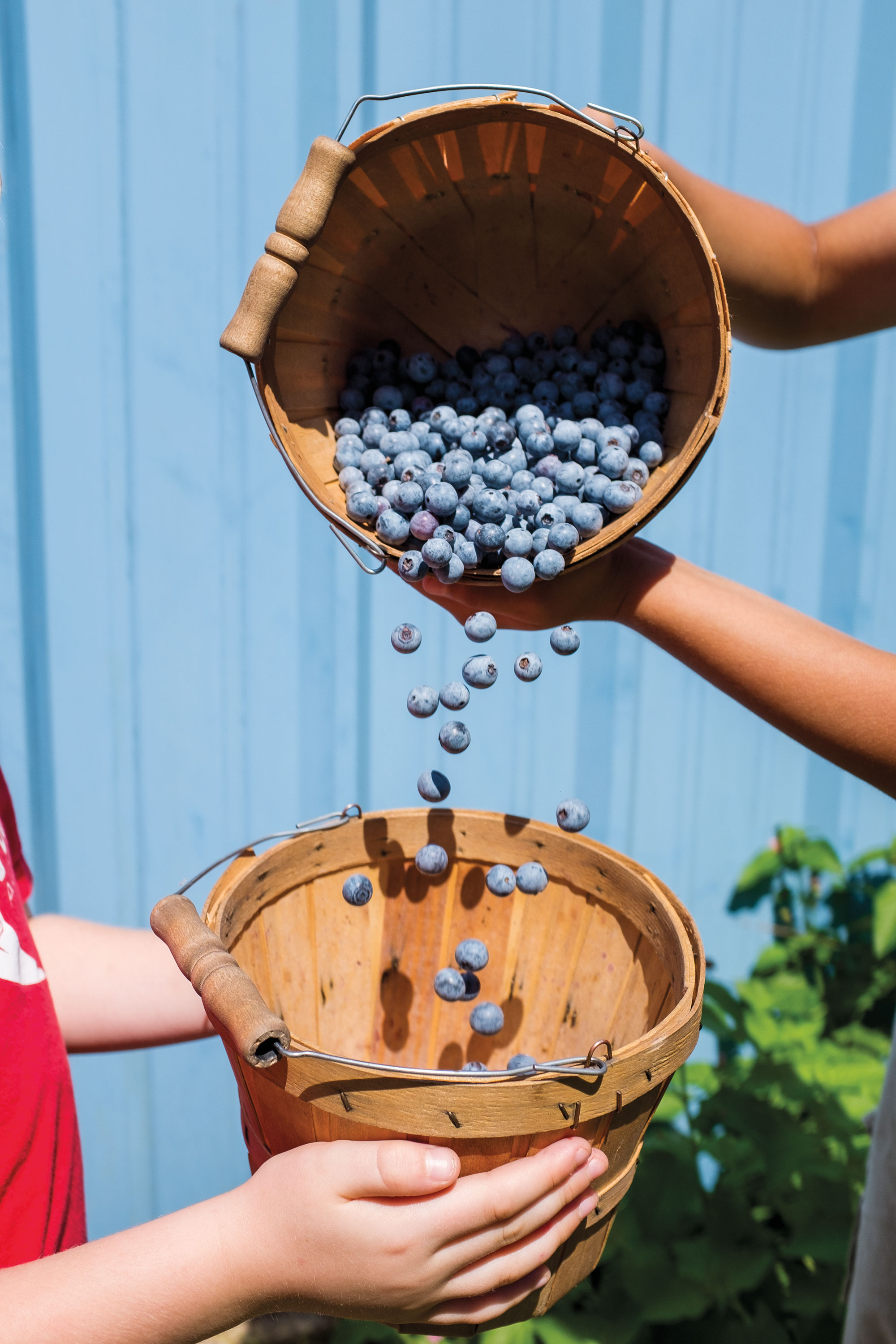
Blueberry Hill Farms in Edom. Photo: Tom McCarthy Jr.
Pick-Your-Own Farms
In addition to its farmers market and community-supported-agriculture (CSA) deliveries, Wood Duck Farm offers limited pick-your-own strawberries and blueberries. Other farms near me—such as Moorhead’s Blueberry Farm and Blakelock’s Blackberries—operate as “you-picks” throughout the season. Fredericksburg’s Marburger Orchard has been a peach-picking spring ritual in my family since my now-30-something children were youngsters. Unfortunately, Marburger Orchard won’t be open to visitors this spring, but Jenschke Orchards is a nice alternative. Decide beforehand on how many pounds you will pick and process, as it’s ever so tempting to over-pick, especially with children helping you (says the lady who once came home
from Moorhead’s with 30 pounds of blueberries).
bestfredericksburgpeaches.com
moorheadsblueberryfarm.com
woodduckfarm.com
blueberryhillfarms.com
Festivals
A family tradition of my longtime friend and avid canner Steve Lightfoot’s clan is to load up the young’uns and the bushel baskets and head to the East Texas burg of Jacksonville for its annual Tomato Fest in June. “I put up enough tomatoes to last the year,” he says, “and use them in soups, spaghetti sauces, and stews, as the flavor’s far superior to the store-canned ones.” Fruitful festivals kick off with Mission’s Texas Citrus Fiesta in January and Weslaco’s Onion Fest in March, closely followed by the Poteet Strawberry Festival in April. June’s events include not only Tomato Fest, but also the Texas Blueberry Festival in Nacogdoches and the Stonewall Peach Jamboree. Cap off your fruit festival
season in September at Idalou’s Apple Butter Festival.
strawberryfestival.com
jacksonvilletexas.com/tomato-fest
texascitrusfiesta.org
tbf.nacogdoches.org
weslaco.com/pages/eventinformation
theorchardtexas.com
stonewalltexas.com/peach_jamboree.html
“Fruitful” Drives
“We’ll often find better prices on bulk tomatoes at the roadside stands on US 69 between Alto and Jacksonville,” Lightfoot says. “We’ve found it’s worthwhile to check a number of them, as well as vendors at the festival itself, before committing to buying.” Likewise, I (much to my husband’s dismay) have been known to visit a half-dozen or more roadside peach stands along US 290 between Stonewall and Fredericksburg, buying and slurping down a peach at each before deciding where I’ll spring for a bushel.
Find fresh winter citrus along the backroads of the Rio Grande Valley’s Hidalgo County, home of the certified-organic G and S Groves Farm in McAllen and a host of other roadside stands including Bachman Farms and Engert Farms in Alamo, the Lazy S Citrus Grove in Mercedes, Thompson’s Rio Pride Citrus in Weslaco, and Wernecke Citrus Farms in Mission.
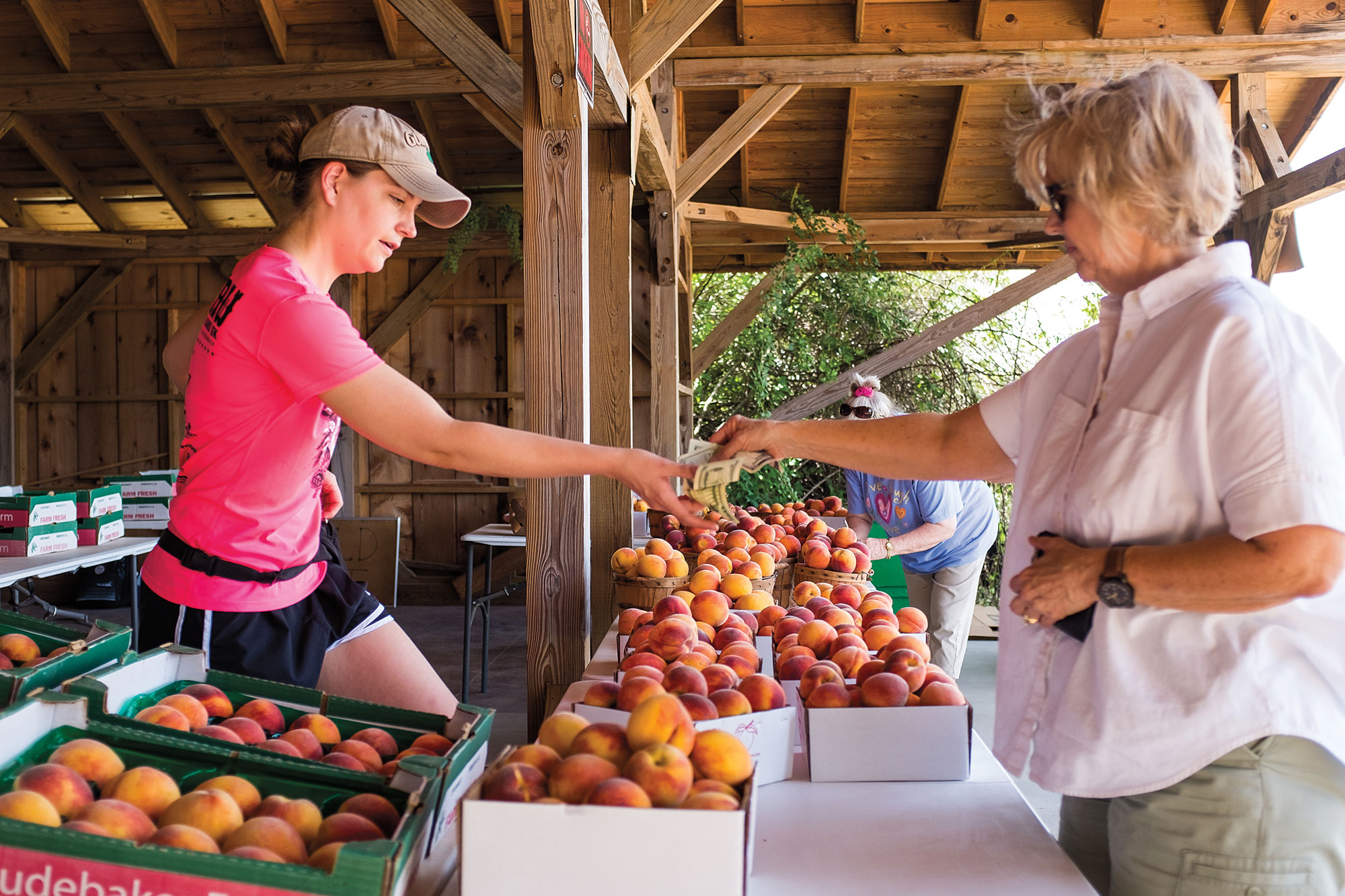
Studebaker Farms in Blumenthal. Photo: Tom McCarthy Jr.
Farm Stands
Visiting stands operated by farmers on their own properties ranks No. 1 as my favorite way to buy fresh produce; I’ve patronized Austin’s Boggy Creek Farm for more than two decades.
I’ll visit other produce farms as my travels take me, seeking out ones that follow sustainable agriculture practices and, ideally, are certified organic. I load up at the G and S Groves stand, where their certified-organic citrus will guarantee that you’re not canning pesticide residues along with your unpeeled oranges.
boggycreekfarm.com
gandsgroves.com
I’m not sure my year-round canning efforts save me money; I’ve never tallied it up, nor do I care to. What I do know is that I experience the joy in sourcing the best of Texas’ fresh fruits and vegetables and of preserving the peak harvest all year long. I get the satisfaction of mastering a core culinary skill, and the pride of serving my home-canned foods to friends and family. Plus, I know Mamaw Grace would be pleased as punch.
Texas A&M AgriLife Extension Service
Food preservation classes are offered on a yearly basis at the Texas A&M AgriLife Extension office in Austin, and at various other locations around the state. Contact your local county agent to determine availability of classes near you.
agrilifeextension.tamu.edu
Yes, You Can Can
Canning is a wonderful method to preserve the harvest, while retaining many of its flavors and nutrients and freeing up valuable real estate in your freezer. “Follow professionally tested recipes and use safe home-canning techniques, for two reasons,” advises Jenna Anding, program leader for Texas A&M AgriLife Extension Service. “First of all, no one wants to get sick. Second, you don’t want to have to toss out spoiled food after all the time and money you’ve invested in preserving it. When you follow professionally tested recipes and use the most current science-based techniques, the result will be shelf-stable for a year or more.”
High-acid foods, such as fruit (including tomato) salsas, relishes, jellies, jams, preserves, and sauces can be processed in a water-bath canner, which reaches 212 degrees. Low-acid foods such as moles, chilis, stews, meats, poultry, and seafood must be heat-processed in a pressure canner so that the temperature rises to 240 degrees, which prevents the formation of Clostridium botulinum, a deadly toxin.
